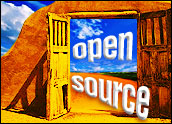
Henry Chesbrough and Eric von Hippel promoted the idea of open innovation as a new paradigm for corporations to reach beyond their own walls as they develop and bring to market new products and services. The idea covered a number of channels for work and ideas, including customers, users and partners. One of the key hurdles becomes the tension between sharing and protecting the innovation to allow all participants to get a return for their investment.
Ideas around open innovation share a lot with ideas of software production using free and open source software licenses and collaborative development communities. Indeed, large FOSS communities are ideal examples of open innovation.
The growth and global participation in open source software development, largely aided by inexpensive and pervasive Internet access, has created a community of collaborators that software developers and IT professionals now depend on as a vital element in the software development process. As software intellectual property practices have matured, free and open source software communities have kept pace.
Corporate Involvement
FOSS licenses have evolved over the past 30 years from the more liberal academic do-as-you-will licenses and initial ideas of software freedom, e.g., the BSD and MIT licenses, and the first GPL. As the software IP landscape evolved, so too did the licenses.
The legal language of FOSS licenses evolved into more corporate-centric discussions of such things as patents. One of the key tools in this IP-handling maturation has been the evolution of the nonprofit technology foundation as a software IP management mechanism, as well as a communications and collaboration hub.
As well-run collaborative FOSS-licensed projects grow and thrive, they reach a point where corporations begin to express interest. Corporations need a way to use and contribute to the software that is IP-friendly from a corporate perspective. This has led to the formation of foundations around key FOSS projects such as the Apache Web server, Linux and the Eclipse IDE. (For the moment, we will put aside corporate-initiated FOSS projects like MySQL.)
A nonprofit FOSS foundation provides legal structure, business operations and technical services to a growing FOSS project. For example, as corporate interest in Apache grew, the Apache project evolved into the Apache Software Foundation with a new Apache License, 2.0, that was clearer in its language with respect to IP.
The Eclipse Project similarly evolved into the Eclipse Foundation with very rigorous IP management practices. The Eclipse license has evolved from the IBM Public License, to the Common Public License, to the Eclipse Public License over the past decade. The Linux Foundation evolved out of the Open Source Development Labs (OSDL).
At this point in history, the Outercurve Foundation, established to provide a forum in which commercial software companies and their developers could work collaboratively with open source communities, is taking this well-defined model and applying it going forward for new FOSS projects.
Provenance Tracking and Neutrality
Part of the legal structure a foundation provides is provenance tracking. Foundations such as Outercurve, Apache and Eclipse have rigorously defined legal structures around provenance tracking for contributions with matching software development practices to support the tracking. Some foundations use contribution license agreements, some build provenance tracking into their membership structures, and some take a more engineering-centric approach and use the configuration management environment.
A recent investigation into FOSS project size and activity found that the nine largest FOSS projects are all centered inside FOSS foundations. The tenth largest (a corporate project) was an order of magnitude smaller.
This idea provides the key to understanding the relationship between foundations and the growth of FOSS projects. While the foundation provides an improved legal structure through better licensing and provenance tracking, it also acts as a neutral space for ownership and collaboration. This gets back to the heart of the IP tension discussed by Chesbrough and von Hippel with respect to open innovation.
For all corporate participants to feel they aren’t giving away their innovation investments to partners and competitors or the public at large, a central neutral owner for the IP becomes essential to growth. Foundations serve as that neutral holder of IP.
This idea goes all the way back in the FOSS world to the early IP management process created by the Free Software Foundation, based on IP assignment to the FSF. Some large projects (notably Apache and Linux) have had to evolve and retrofit neutrality onto projects that had somewhat messy beginnings with respect to ownership. Now these projects thrive.
Foundations protect neutrality through their governance structures and bylaws, such that participants are equals and no participant has any particular advantage over the others.
This idea of neutral ownership also exposes the concerns often raised about the reverse situation. No one would deny the MySQL database project is one of the more successful FOSS projects over the past two decades. That said, ownership was held in a single company. The company maintained rigorous IP practices to protect its assets and investments, including requiring contributors to assign ownership of their contributions over to the company.
Indeed, the company hired many of the best contributors over time. Then MySQL was acquired by Sun Microsystems, which was later acquired by Oracle, a company not known for its broad collaborative innovation efforts. Indeed, over the past two years, the MySQL world has been collapsing as people abandon it for a myriad of competing solutions.
The Internet removed enormous friction from the software collaboration world, enabling people to share and develop software much more easily. But open innovation in software needs more than the Information Superhighway. Legal structures enabled by better licenses and provenance tracking are required to give corporations confidence as they participate. Ultimately, the neutrality provided by FOSS foundations is the key to real growth and dynamism for FOSS projects as they grow and thrive.











































